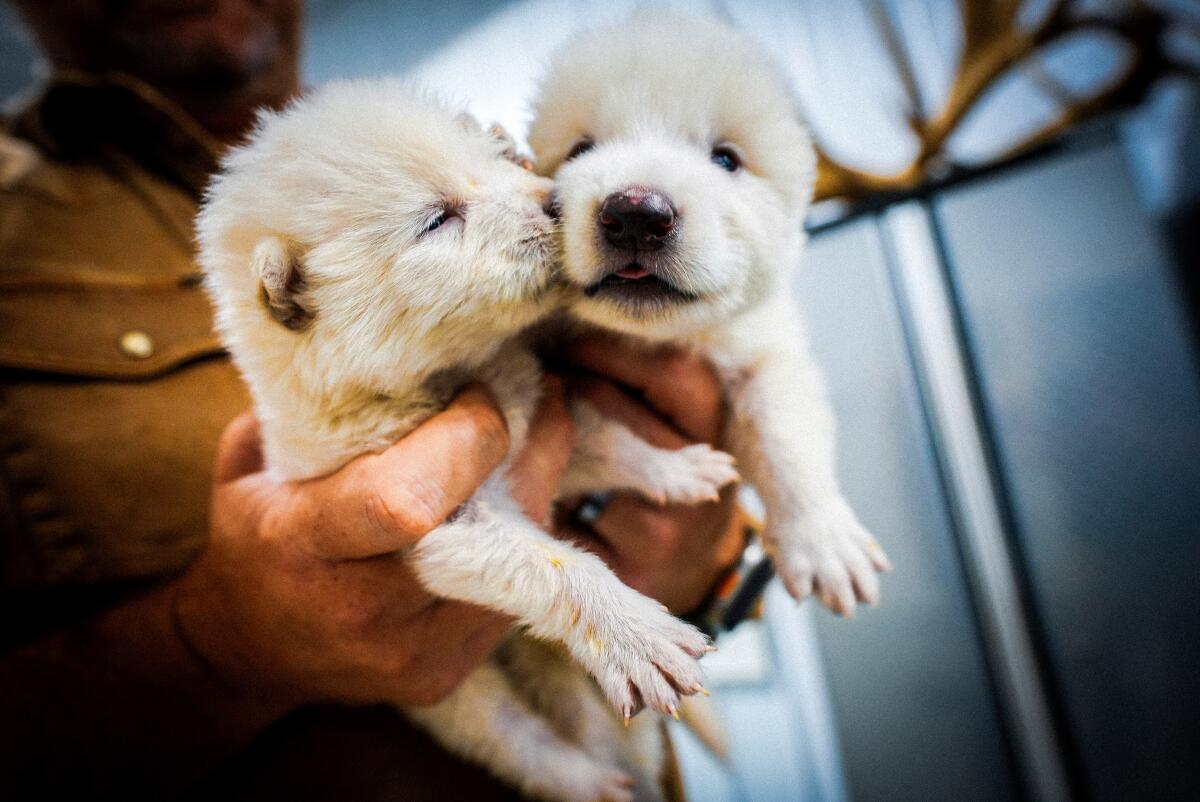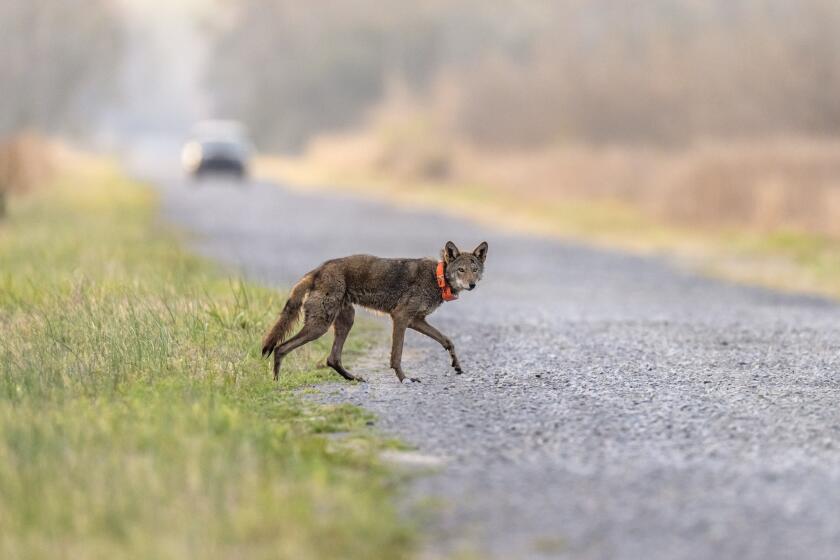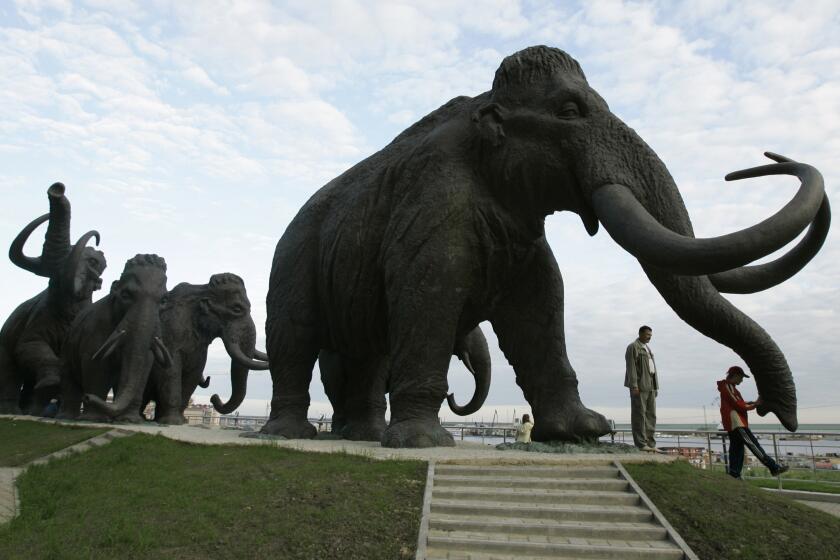Scientists say they ‘de-extincted’ dire wolves. Experts at La Brea Tar Pits are skeptical

- Share via
When news broke that scientists in Texas had succesfully reintroduced the long-extinct dire wolf to the modern world, more people than just “Game of Thrones” fans took notice.
Researchers at the Natural History Museum’s La Brea Tar Pits, where a wall is decorated with hundreds of dire wolf skulls, had questions.
Namely, are they really dire wolves? Turns out, it depends on how you define it.
“What they have created is basically a genetically engineered gray wolf that has been given genetic traits so they can express morphological or physical traits that more resemble dire wolves,” said Kayce Bell, a terrestrial mammal curator at the Natural History Museum. “The technology and the tools that they are developing with this work are incredible and very powerful, but the terms that are being used to discuss it, I think, are misleading.”
Earlier this week, biotechnology company Colossal Biosciences in Dallas announced they had “de-extincted” the dire wolf, sharing the news of the births of three healthy pups. Over 18 months, experts there extracted and sequenced ancient DNA from two dire wolf fossils — a 13,000-year-old tooth from Sheridan Pit, Ohio, and a 72,000-year-old inner ear bone from American Falls, Idaho. With that ancient DNA, scientists identified gene variants specific to dire wolves and then performed multiplex gene editing with a genome from the gray wolf, dire wolves’ closest living relatives. They used domestic dogs as surrogate mothers to birth the three pups.

Colossal’s chief science officer, Beth Shapiro, said she understands the scientific skepticism that came with the announcement.
“I get it,” she said. “It’s frustrating when you work in paleontology and you feel like it’s not effective science communication, and I wish I’d done a bit better.”
Though Southern California has a jackpot of dire wolf fossils relative to other sites, extracting DNA from the local samples is difficult. Shapiro said she’s been trying and unable to collect DNA from local samples for 20 years. Among the reasons it’s challenging to collect, experts say, is that L.A.’s urban landscape bakes in the sun, heating up the asphalt, which could degrade ancient DNA buried underneath.
The Wilshire Boulevard landmark poses many tantalizing questions that scientists are trying to solve.
La Brea Tar Pits has the highest concentration of dire wolf fossils in the world, with remains from over 4,000 dire wolves found at the site. They lived in the region for at least 50,000 years, disappearing about 13,000 years ago.
“There’s no other site on Earth that even comes close to that,” said Emily Lindsey, the associate curator and excavation site director at La Brea Tar Pits.
Dire wolves, native to Southern California but not limited to the region, were highly adaptable and had a very wide range of environmental tolerances before the species went extinct about 10,000 years ago, Lindsey said.
The three pups — Romulus and Remus, who were born in October, and Khaleesi, born in January — now live on an ecological preserve at an undisclosed location that spans over 2,000 acres and hosts 10 full-time staff members who care for and observe them. The preserve is certified by the American Humane Society and registered with the U.S. Department of Agriculture.
Depending on how you look at it, that could be dire wolf territory now.
In 2016, the International Union for Conservation of Nature published a report that focused on de-extinction and defined it as “bringing back a proxy of an extinct species that resembles it in some way, phenotypically, physiologically, ecologically,” Shapiro said.
But in the end, she said she’s not really hung up on what the animals are called beyond their names, inspired by founders of Rome and the “Game of Thrones” show.
“Call it a de-extinct dire wolf that abides by the definition that the scientific community agreed on 10 years ago. Call it Colossal’s dire wolf. Call it a gray wolf with 20 edits that looks and acts like a dire wolf and is a functional replacement for a dire wolf,” Shapiro said.
Part of Colossal’s announcement this week included news that they had also successfully created four clones of the endangered red wolf using a new noninvasive cloning technology. Both Lindsey and Bell said they appreciated Colossal’s work on conserving endangered species, but think that focusing on conservation is a more productive use of resources.
There are only 13 red wolves in the wild. But in North Carolina, where wildlife experts hope to save the species, many landowners see them as a nuisance.
“There are potentially useful applications of some of these technologies, particularly for preventing highly endangered species from going extinct. I think that would be a far more efficient application of these technologies than trying to bring something resembling an extinct species back to life,” Lindsey said. “I’d hate to have to be trying to de-extinct wolves once they go extinct, right?”
Colossal’s Chief Executive Ben Lamm said the company wants to pair their “de-extinction events” with work they’re doing to protect critically endangered species. The company’s other de-extinction hopes include reviving the woolly mammoth, the dodo, and the thylacine, or Tasmanian tiger. To Lamm and Shapiro, de-extinction and conservation can work in tandem.
The ‘de-extinction’ company Colossal and the conservation group Re:wild found common ground in the potential of genetic technology to rescue today’s disappearing creatures.
“Conservation and de-extinction are not at odds with each other. The de-extinction toolkit should be part of the increasing number of ways that we have at our fingertips to be able to help endangered species survive,” Shapiro said.
Lamm, who held up drawings of dodos and other extinct animals children had sent to the Colossal team during a Zoom interview with The Times, said he thinks the milestone could also inspire more people to pursue careers in related fields.
“The world needs a little hope right now, and I think the world needs more science. Hopefully, we’re providing a little bit of both,” he said.
And yes, of course “Jurassic Park” quotes and references are tossed Lamm and Shapiro’s way with stunning frequency.
“People actually say to us, ‘Don’t you know what happened in Jurassic Park?,’ equating it to, like, Chernobyl,” Lamm said. “ ‘Didn’t you see what happened there?’ Not, ‘Didn’t you watch the movie and learn anything about human hubris from the movie?’ They don’t say that.”
Shapiro added: “People are yelling at us that these aren’t real dire wolves. But no one has ever questioned whether the dinosaurs in ‘Jurassic Park’ are real dinosaurs.”
While the debate is still open, Lindsey said she invites anyone curious about the creatures to visit La Brea Tar Pits to see some of the “real dire wolves” that they have excavated at the site.
“It’s a really cool opportunity — one that you don’t get in almost any other city in the world — to come and really see the incredible diversity of large animals that lived here until very recently,” Lindsey said.
More to Read
Sign up for Essential California
The most important California stories and recommendations in your inbox every morning.
You may occasionally receive promotional content from the Los Angeles Times.













